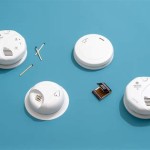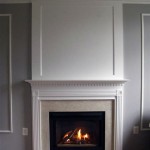TV Over Fireplace: Strategically Positioning Your Cable Box
Mounting a television above a fireplace has become an increasingly popular design choice in modern homes, offering a streamlined and aesthetically pleasing entertainment setup. This configuration, however, presents unique challenges when it comes to effectively managing and concealing the necessary components, particularly the cable box. Determining the optimal placement for the cable box is crucial for maintaining a clean visual aesthetic while ensuring proper functionality and accessibility.
Successfully integrating a cable box into a TV-over-fireplace setup requires careful consideration of several factors, including the existing infrastructure, the desired level of concealment, accessibility for maintenance or troubleshooting, and adherence to safety guidelines. Ignoring these elements can lead to unsightly cable clutter, potential interference with the fireplace functionality, and increased difficulty in accessing the cable box for adjustments or repairs. This article will explore various placement options for your cable box when mounting a TV above a fireplace, providing guidance on how to make the best choice for your specific situation.
Behind the Television: The Pros and Cons
One of the most common approaches is to conceal the cable box directly behind the television. This method offers maximal concealment, keeping the device completely out of sight. However, this placement strategy is not without its drawbacks. First, adequate space behind the television is essential to accommodate the cable box and its associated cables. The back of the TV needs to be flush with the wall, and if the recess is not deep enough, the TV installation may not be possible. Second, heat generated by both the television and the cable box can become a concern. Enclosed spaces can trap heat, potentially leading to overheating and reduced lifespan for the electronic components. Ventilation is therefore paramount. Third, gaining access to the cable box for maintenance or adjustments can be cumbersome, often requiring the removal of the television from its mount.
To mitigate heat buildup, consider installing a small fan within the space behind the TV to promote airflow. Using a ventilated mount can also help dissipate heat. Furthermore, ensure that all cables are properly managed and secured to prevent them from interfering with the fan or obstructing airflow. When considering this placement option, carefully measure the available space and assess the potential for heat accumulation. If the space is limited or ventilation is inadequate, alternative solutions should be explored.
Infrared (IR) signal transmission can also pose a challenge when the cable box is hidden behind the television. As the TV blocks the IR signal from the remote control, using an IR repeater is typically necessary. An IR repeater consists of a small receiver placed in a visible location (e.g., near the bottom of the television) that relays the remote control signals to the cable box behind the TV. This ensures that you can control the cable box without needing to point the remote directly at it. This solution, however, adds another component to the setup and requires careful placement of the IR receiver.
In a Nearby Cabinet or Closet: Remote Access Solutions
Placing the cable box in a nearby cabinet or closet offers an alternative approach that prioritizes accessibility and ventilation. This strategy offers greater flexibility in terms of space and airflow, making it easier to manage heat and access the device for maintenance. However, this solution introduces the challenge of transmitting the video and audio signals from the cable box to the television and ensuring remote control functionality.
To transmit the video and audio signals, high-quality HDMI cables can be run through the wall from the cabinet or closet to the television. Concealing these cables within the wall requires careful planning and may involve cutting and patching drywall. Alternatively, cable management systems, such as cable raceways or wire moldings, can be used to conceal the cables along the wall surface. Choosing cables that are rated for in-wall use is crucial for safety and compliance with building codes. Ensure that the cables are properly secured and protected from damage.
Remote control functionality can be achieved using an IR repeater or a radio frequency (RF) remote control. An IR repeater, as described earlier, extends the range of the remote control by relaying the signals to the cable box. An RF remote control, on the other hand, uses radio waves to communicate with the cable box, allowing it to be controlled from anywhere within range, regardless of obstructions. RF remote controls typically require a base station or receiver connected to the cable box. While RF remotes offer greater flexibility, they may be more expensive than IR repeaters. Selecting the appropriate remote control solution depends on the specific layout of the room and the desired level of convenience.
On a Shelf Below the Fireplace: Visibility Considerations
If completely concealing the cable box is not a primary concern, placing it on a shelf or in an open cabinet below the fireplace is a simpler and more accessible option. This strategy offers the advantage of easy access for maintenance and adjustments, while also providing adequate ventilation. However, this placement option sacrifices visual aesthetics, as the cable box will be visible. Effective cable management is crucial to minimize visual clutter.
To improve the aesthetics of this setup, consider using a decorative shelf or cabinet that complements the style of the room. Select a cable box with a visually appealing design. Employ cable management techniques to neatly organize and conceal the cables. Use cable ties, zip ties, or cable sleeves to bundle the cables together and prevent them from tangling. Route the cables along the back of the shelf or cabinet and conceal them with cable covers or channels. The objective is to minimize the visibility of the cables and create a more organized and aesthetically pleasing appearance.
When placing the cable box below the fireplace, ensure that it is not exposed to excessive heat from the fireplace. Heat can damage the electronic components of the cable box and shorten its lifespan. Maintain a safe distance between the cable box and the fireplace. Consider using a heat shield or barrier to protect the cable box from radiant heat. Regularly monitor the temperature around the cable box to ensure that it remains within safe operating limits.

How To Hide The Cable Box

How To Hide The Cable Box Tv Cords Wires

Hide Cords Of A Tv Mounted Over Fireplace Powerbridge

How To Hide A Cable Box In 5 Easy Steps Home Like You Mean It

How To Hide The Cable Box

Tv Wall Mount Installation With Wire Concealment Over Fireplace

Help With Where To Put Cable Box And Other Tv Items For Clean Look

Stylish Tv Above Fireplace With Cable Box

Over Mantle Cabinet For Tv Components How To

Where To Put Cable Box When Tv Is Above Fireplace Storables
Related Posts








